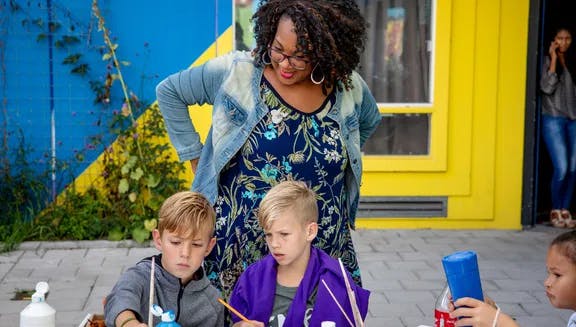
International education vs. Dutch schools
Choosing the right education path for your children
Choosing the best education path for your child is a challenge for every parent, no matter where you live. But for international newcomers in the Amsterdam Area, the choice may feel even more daunting. Will you send your kids to an international school? Would they be happier in a local Dutch school? Of course, every situation is different, so there are no right or wrong answers. Read on to better understand some of the key factors, then draw up a list of pros and cons that fit your family. For more advice, check out our tips for helping your child adjust to a new school.
The age of your child
Age is an important factor. From the parents’ perspective, if you have young children, you probably haven't had as much experience in the education system and in making schooling choices, but you definitely want to set them on the best path as early as possible. If your kids are older, you’ve already started them on a path and you may feel more confident in knowing what suits them. But, of course, age is just as important to your child and it defines what their options actually are.
Primary education in the Netherlands

If your children are only four or five years old, they can usually start at a Dutch primary school even if they haven’t spoken Dutch before. The first two years of education in the Netherlands focus primarily on language acquisition, social and motor skills, and preparing them for reading and writing. From the age of six, they would be required to follow a Dutch immersion programme, such as a newcomers’ class (nieuwkomers klassen) or an international language class (internationale taalklas). After one year they can begin regular Dutch education.
Did you know that Dutch primary schools don’t typically assign homework? So as a (possibly) non-Dutch speaking parent you won’t need to worry about language barriers if your child asks for help.
Secondary education in the Netherlands
If your child is of secondary school age (12 and over), there are many more language challenges for the child to face. For example, the CITO is the central end test for primary education that pupils take in their last year of primary school. It tests their Dutch language and comprehension skills, mathematics, study skills and world orientation. From this, they are typically moved into an appropriate education stream at a secondary school which offers the appropriate courses at the right level. The assessment of the teacher is the deciding factor.
The biggest problem for international children is often that insufficient Dutch language skills can have a negative influence on their secondary school recommendation. If they want to improve their Dutch and focus on achieving a better recommendation, attending a Kopklas for one year may be a good option. This is a one-year extension of primary school, intended for bright students who typically perform better than their test results suggest, and are probably being held back by their language skills. From the age of 12 and up, another option is to attend an international bridge class (ISK, internationale schakelklas). But this often means that you lose a year because you need sufficient language skills to be successful in all the tests that determine the level of secondary education.
It’s good to keep in mind that if your child doesn’t seem suited to a university preparatory education stream (VWO), an ISK may be a good option, as there may be more freedom to take an extra year. If the VWO is a fitting stream, the International Baccalaureate level offered by many international schools is certainly an equivalent. And your teenager may find it easier to settle and adapt to the international school environment.
School curriculum

As is common around the world, Dutch schools offer many different types of education, following specific religious, philosophical or pedagogic principles. But all schools must adhere to the ‘core education objectives’ set out by the Dutch government. Get to know the various education paths for secondary education in the Netherlands.
A growing number of schools in the Netherlands now offer a bilingual curriculum, where Dutch and English may be treated (almost) equally. Some bilingual schools will expect your child to be comfortable in one of their teaching languages when starting.
International schools typically follow the International Baccalaureate (IB); British schools typically follow the British Curriculum but may also offer IB streams; European Schools follow the European Baccalaureate in which the curriculum is delivered in different languages.
Does the cost of education matter?
Perhaps one of the simplest questions to answer is that of cost. Dutch schools are government-funded. Parents may be asked to pay a small (voluntary) contribution. In regards to international schools, some are partly subsidised, resulting in fees of around €5,500 per child. Private international schools can cost €12,000 to €24,000 per child.
Length of your stay in the Netherlands
If you have the coming few years mapped out, this can be another simple factor to consider. If you only plan to live in the Netherlands for 2 or 3 years, sending your child to an international primary or secondary school can help provide them continuity on arrival, and also in their move to a new country – or back home. If you are consciously looking to remain in the Netherlands for a longer period, attending a Dutch school will help your child to learn Dutch quicker and to integrate into local culture.
Holidays
If you travel a lot for work or visit family back home frequently, it’s also handy to know what to expect from school vacations. Dutch schools have a six-week summer vacation, plus one-week breaks in February and autumn and a two-week break in May. Keep in mind that school attendance is mandatory and schools apply the law strictly. By comparison, international schools have fewer official breaks throughout the year and often make use of longer school days. However, they may be more flexible when it comes to time off for pre-arranged travel.
Meeting people and making friends

Although sitting near the end of this article, the social aspects of your school choice shouldn’t be underestimated – both for the parent and child.
Benefits of international schools can seem obvious: there are lots of parents and children in the same boat; it’s a truly multicultural (and sometimes multilingual) environment; and communication with the teachers and school administration may flow more smoothly. But the friendships formed at an international school may be with children living in other towns or cities, while families come and go regularly, meaning your children have to keep making new friends. And while your child will receive some basic Dutch lessons at an international school, the standard isn’t likely to be high enough to allow them to transfer to a Dutch school.
Building bonds at a Dutch school may require more effort and take longer, but this can result in strong friendships. Particularly when you consider that most pupils will be local to the neighbourhood and will walk or bike to school together.
For further food for thought, learn more about the Dutch education system and the options available in the Amsterdam Area.
Related articles

Primary school

Newcomers' classes for primary school children

Understanding the Dutch school system

International native language schools

Secondary School

International schools in the Amsterdam Area

Preschool

Out-of-school Care (BSO)

Find the right school
